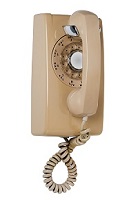I was asked recently how the U.S. Bureau of Labor Statistics can collect data these days when no one answers the telephone. A legitimate question and one we grapple with all the time. I had two answers – one related to data collection methods and one related to sources of data. I will elaborate here about both.

But first, do you remember the days before caller ID, when everyone answered the phone? If you were at home, the rotary phone, permanently attached to the kitchen wall, always rang during dinner.
If you were in the office, the phone probably had a row of clear plastic buttons at the bottom that would light up and flash. In either case, who was on the other end of the phone was a mystery until you answered. In those days, your friendly BLS caller could easily get through to you and ask for information.

Fast forward to today’s world of smart phones and other mobile devices. Nobody talks on the phone anymore. Many phone calls are nuisances. A call from BLS might show up as Unknown Number, U.S. Government, or U.S. Department of Labor on your caller ID, or identified as potential spam. With the spread of “spoofing,” many people do not answer calls from numbers they don’t recognize. How do we get around these issues?
Data Collection
At BLS, we consider data collection as much an art as a science. Sure, our staff needs to be well-versed in the information they are collecting. But they also need to be salespersons, able to convince busy people to spend a few minutes answering key questions. Part of that art is making a connection. There are old-fashioned ways that still work, such as sending a letter or showing up at the door. And there are more modern techniques, such as email and text. We are nothing if not persistent.
Our data-collection techniques have been called “High Touch, High Tech.” We start by building a relationship—the High Touch step. BLS has a wide range of information that people and businesses can use to help make informed decisions. We can help you access that information, and we love to see survey respondents use BLS data they helped us produce. In return, we ask for some information from you. There’s where High Tech comes in. We continue to add flexibility to our data-collection toolkit. You can provide information in person, on paper, or on the phone. You also can email information or an encrypted file. Or you can access our online portal anytime and anywhere to provide information or upload a data file. We need your information, and we want to make providing that information as easy as possible.
For example, this chart shows the number of employer self-reports that we’ve received through our online portal over the past several years. Internet data collection has really taken off.

Editor’s note: Data for this chart are available in the table below.
Another data-collection strategy we use is asking businesses to allow us to get the information we need from their website. This might involve web scraping data or using an Application Programming Interface (API). We have had success showing businesses that we can get what we need from their website, often eliminating the need for them to compile data.
Alternative Data
Beyond these data-collection strategies, we are expanding efforts to get information from alternative sources, lessening our need to contact businesses and households. Some BLS programs, such as Local Area Unemployment Statistics, the Quarterly Census of Employment and Wages, and Productivity Studies, rely heavily on administrative data and information from other surveys. In these cases, there is little need to contact businesses or people directly.
Other BLS programs, such as the Consumer Price Index (CPI) and the Employment Cost Index (ECI), need to capture timely information. But there are alternatives that can complement direct data collection. The CPI, for example, has produced an experimental price index for new vehicles based on a file of vehicle purchase transactions provided by J.D. Power. Using information from sources like that may eventually lessen the need to have BLS employees contact vehicle dealerships. The ECI found that it was easier to capture employer premiums for unemployment insurance from state tax records than to ask employers.
Alternative data come in many forms, from government records, data aggregators, scanners, crowdsourcing, corporate data files, and many more. BLS is investing heavily in alternative data-collection techniques and alternative data sources. The High Touch and High Tech approach we use every day in our data-collection operations helps us to maximize data quality and minimize respondent burden and cost.
The telephone may go the way of the dinosaur, but that’s not stopping us from using every tool at our disposal to continue to produce gold standard data to inform your decisions.
| Year | Number of transactions |
|---|---|
|
2004 |
105,145 |
|
2005 |
148,754 |
|
2006 |
219,923 |
|
2007 |
534,555 |
|
2008 |
972,605 |
|
2009 |
1,544,795 |
|
2010 |
1,909,410 |
|
2011 |
2,322,540 |
|
2012 |
2,769,694 |
|
2013 |
3,236,376 |
|
2014 |
3,288,665 |
|
2015 |
3,554,639 |
|
2016 |
4,013,415 |
|
2017 |
4,513,297 |
|
2018 |
4,685,414 |
|
2019 |
4,868,939 |
 United States Department of Labor
United States Department of Labor